OFDM Baseband Receiver Design
for Wireless Communications
OFDM Baseband Receiver Design for Wireless Communications
© 2007 John Wiley & Sons (Asia) Pte Ltd. ISBN: 978-0-470-82234-0
Tzi-Dar Chiueh and Pei-Yun Tsai
�
OFDM Baseband Receiver
Design for Wireless
Communications
Tzi-Dar Chiueh
National Taiwan University, Taiwan
Pei-Yun Tsai
National Central University, Taiwan
John Wiley and Sons (Asia) Pte Ltd
�
Copyright ß 2007
John Wiley & Sons (Asia) Pte Ltd, 2 Clementi Loop, # 02-01,
Singapore 129809, tel: 65-64632400
Visit our Home Page on www.wiley.com
All Rights Reserved. No part of this publication may be reproduced, stored in a retrieval system, or transmitted in
any form or by any means, electronic, mechanical, photocopying, recording, scanning, or otherwise, except as
expressly permitted by law, without either the prior written permission of the Publisher, or authorization
through payment of the appropriate photocopy fee to the Copyright Clearance Center. Requests for permission
should be addressed to the Publisher, fax: 65-64646912, email:enquiry@wiley.com.sg
Designations used by companies to distinguish their products are often claimed as trademarks. All brand names and
product names used in this book are trade names, service marks, trademarks or registered trademarks of their
respective owners. The Publisher is not associated with any product or vendor mentioned in this book. All
trademarks referred to in the text of this publication are the property of their respective owners.
This publication is designed to provide accurate and authoritative information in regard to the subject matter
covered. It is sold on the understanding that the Publisher is not engaged in rendering professional services. If
professional advice or other expert assistance is required, the services of a competent professional should be
sought.
Other Wiley Editorial Offices
John Wiley & Sons Ltd, The Atrium, Southern Gate, Chichester, West Sussex PO19 8SQ, UK
John Wiley & Sons Inc., 111 River Street, Hoboken, NJ 07030, USA
Jossey-Bass, 989 Market Street, San Francisco, CA 94103-1741, USA
Wiley-VCH Verlag GmbH, Boschstr. 12, D-69469 Weinheim, Germany
John Wiley & Sons Australia Ltd, 42 McDougall Street, Milton, Queensland 4064, Australia
John Wiley & Sons Canada Ltd, 6045 Freemont Blvd, Mississauga, Ontario, L5R 4J3, Canada
Wiley also publishes its books in a variety of electronic formats. Some content that appears in print may not be
available in electronic books.
Anniversary Logo Design: Richard J. Pacifico
Library of Congress Cataloging-in-Publication Data
Chiueh, Tzi-Dar, 1960-
OFDM Baseband receiver design for wireless communications / Tzi-Dar Chiueh, Pei-Yun Tsai.
p. cm.
Includes index.
ISBN 978-0-470-82234-0 (cloth)
1. Wireless communication systems. I. Tsai, Pei-Yun. II. Title.
TK5103.2.C4657 2007
621. 384–dc22
ISBN 978-0-470-82234-0 (HB)
2007020124
Typeset in 10/12pt Times by Thomson Digital Noida, India
Printed and bound in Singapore by Markono Print Media Pte Ltd
This book is printed on acid-free paper responsibly manufactured from sustainable forestry
in which at least two trees are planted for each one used for paper production.
�
To my Dad Chin-Mu, my wife Jill, my daughter Joanne, and my son Kevin.
–Tzi-Dar Chiueh
To my families for their constant encouragement and support.
–Pei-Yun Tsai
�
Contents
Preface
About the Authors
Acknowledgements
1. Introduction
1.1 Wireless Communication Systems
1.1.1 Digital Broadcasting Systems
1.1.2 Mobile Cellular Systems
1.1.3 Wireless Network Systems
Bibliography
2. Digital Modulation
2.1 Single-Carrier Modulation
2.1.1 Power Spectral Densities of Modulation Signals
2.1.2 PSK, QAM and ASK
2.1.3 CPFSK and MSK
2.1.4 Pulse Shaping and Windowing
2.2 Multi-Carrier Modulation
2.2.1 Orthogonal Frequency-Division Multiplexing
2.2.2 OFDM-Related Issues
2.2.3 OFDM Transceiver Architecture
2.2.4 OFDM System Examples
Bibliography
xi
xv
xvii
1
1
1
3
5
8
9
9
11
11
14
15
17
19
19
24
26
28
�
viii
Contents
3. Multiple Access and Error-Correcting Codes
3.1 Multiple Access
3.1.1 Frequency-Division Multiple Access (FDMA)
3.1.2 Time-Division Multiple Access (TDMA)
3.1.3 Code-Division Multiple Access (CDMA)
3.1.4 Carrier Sense Multiple Access (CSMA)
3.2 Spread Spectrum and CDMA
3.2.1 PN Codes
3.2.2 Direct-Sequence Spread Spectrum
3.2.3 Frequency-Hopping Spread Spectrum
3.3 Error-Correcting Codes
3.3.1 Block Codes
3.3.2 Reed-Solomon Codes
3.3.3 Convolutional Codes
3.3.4 Low-Density Parity-Check Codes
Bibliography
4. Signal Propagation and Channel Model
4.1 Introduction
4.2 Wireless Channel Propagation
4.2.1 Path Loss and Shadowing
4.2.2 Multipath Fading
4.2.3 Multipath Channel Parameters
4.3 Front-End Electronics Effects
4.3.1 Carrier Frequency Offset
4.3.2 Sampling Clock Offset
4.3.3 Phase Noise
4.3.4 IQ Imbalance and DC Offset
4.3.5 Power Amplifier Nonlinearity
4.4 Channel Model
4.4.1 Model for Front-End Impairments
4.4.2 Multipath Rayleigh Fader Model
4.4.3 Channel Models Used in Standards
Bibliography
5. Synchronization
5.1 Introduction
5.2 Synchronization Issues
5.2.1 Synchronization Errors
5.2.2 Effects of Synchronization Errors
5.2.3 Consideration for Estimation and Compensation
5.3 Detection/Estimation of Synchronization Errors
5.3.1 Symbol Timing Detection
5.3.2 Carrier Frequency Offset Estimation
31
31
31
31
33
34
35
35
38
40
41
42
45
48
53
56
59
59
59
60
61
62
68
68
69
70
70
73
74
75
77
78
84
85
85
86
86
86
90
91
91
100
�
Contents
5.3.3 Residual CFO and SCO Estimation
5.3.4 Carrier Phase Estimation
5.4 Recovery of Synchronization Errors
5.4.1 Carrier Frequency Offset Compensation
5.4.2 Sampling Clock Offset Compensation
Bibliography
6. Channel Estimation and Equalization
6.1 Introduction
6.2 Pilot Pattern
6.3 Pilot-Based Channel Estimation
6.3.1 Channel Estimation by Block-Type Pilot Symbols
6.3.2 Channel Estimation by Comb-Type Pilot Symbols
6.3.3 Channel Estimation by Grid-Type Pilot Symbols
6.4 Adaptive Channel Estimation
6.5 Equalization
6.5.1 One-Tap Equalizer
6.5.2 Multiple-Tap Equalizer
Bibliography
7. MIMO Techniques
7.1 Introduction
7.2 MIMO Basics
7.2.1 Capacity
7.2.2 Diversity
7.3 MIMO–OFDM
7.3.1 MIMO Pilot Pattern
7.3.2 MIMO–OFDM Synchronization
7.3.3 MIMO–OFDM Channel Estimation
7.4 MIMO Encoding and Detection
7.4.1 Space Block Codes
7.4.2 Spatial Multiplexing
7.4.3 Spatial De-correlation
Bibliography
8. From Algorithm to Bit-True Design
8.1 Design Flow Overview
8.2 Effect of Additive Impairment Sources
8.3 Analog-to-Digital Conversion
8.3.1 ADC Distortions
8.3.2 Signal Probability Distributions
8.3.3 Dynamic Range and Precision Setting
8.4 Finite Precision Effect in Digital Baseband Processing
8.4.1 Fixed-Point Data Format
8.4.2 Fixed-Point Error Model
ix
104
107
107
108
110
113
115
115
116
118
122
125
132
137
138
138
138
140
143
143
145
145
146
147
149
151
155
158
158
161
167
170
171
171
174
176
176
178
180
181
182
182
�
x
Contents
8.4.3 Finite Precision Effect in FIR Filters
8.4.4 Finite Precision Effect in IIR Filters
8.5 Conversion from Floating-Point Design to Bit-True Design
Interpolative Design Flow
8.5.1 Metrics for Performance Evaluation
8.5.2
8.5.3 Simulation-Based Approaches
8.5.4 Analytical Approaches
Bibliography
9. Circuit Techniques
9.1 Introduction
9.2 FFT
9.2.1 FFT Algorithms
9.2.2 Architecture
9.2.3 Comparison
9.3 Delay Buffer
9.3.1 SRAM/Register File-Based Delay Buffer
9.3.2 Pointer-Based Delay Buffer
9.3.3 Gated Clock Strategy
9.3.4 Comparison
9.4 Circuits for Rectangular-to-Polar Conversion
9.4.1 Arctangent Function
9.4.2 Magnitude Function
9.4.3 Comparison
9.5 Circuits for Polar-to-Rectangular Conversion
9.5.1 Trigonometric Approximation
9.5.2 Polynomial Approximation
9.5.3 Comparison
Bibliography
10. System Examples
10.1 MC-CDMA Downlink Receiver IC
10.1.1 System Description
10.1.2 Transmitter and Receiver Design
10.1.3 Circuit Design
10.1.4 Experimental Results
10.2 MIMO–OFDM Cognitive Radio Receiver IC
10.2.1 System Overview
10.2.2 Architecture and Circuit Design
10.2.3 Experimental Results
Bibliography
Index
187
188
189
190
190
192
192
194
195
195
195
196
201
206
208
209
211
212
214
216
216
221
225
225
228
229
230
231
233
233
234
234
238
241
243
243
245
250
252
255
�
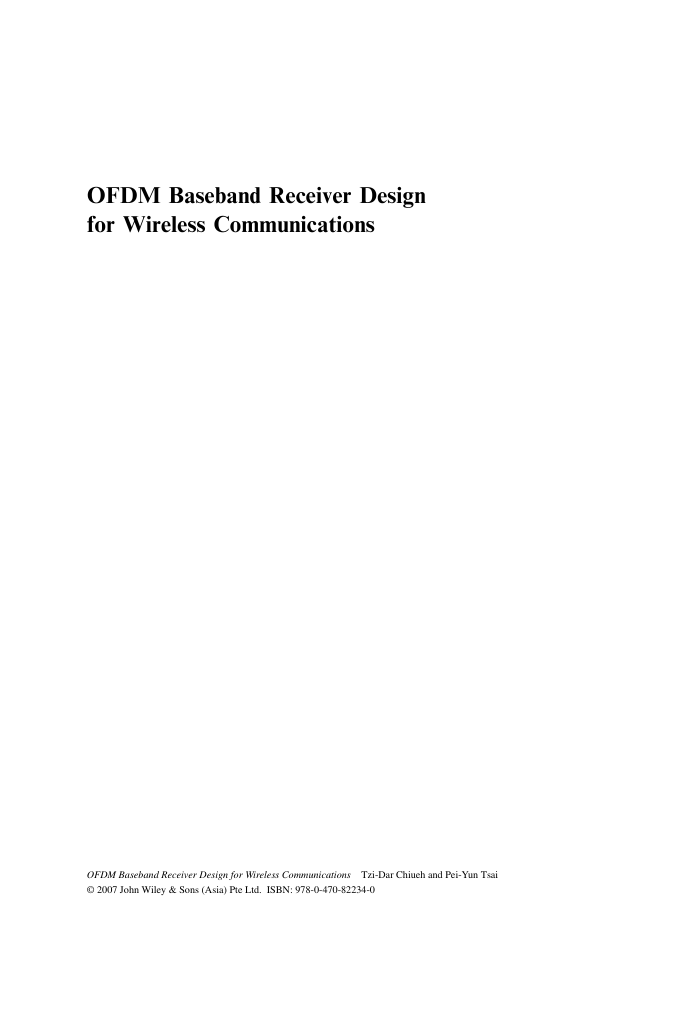
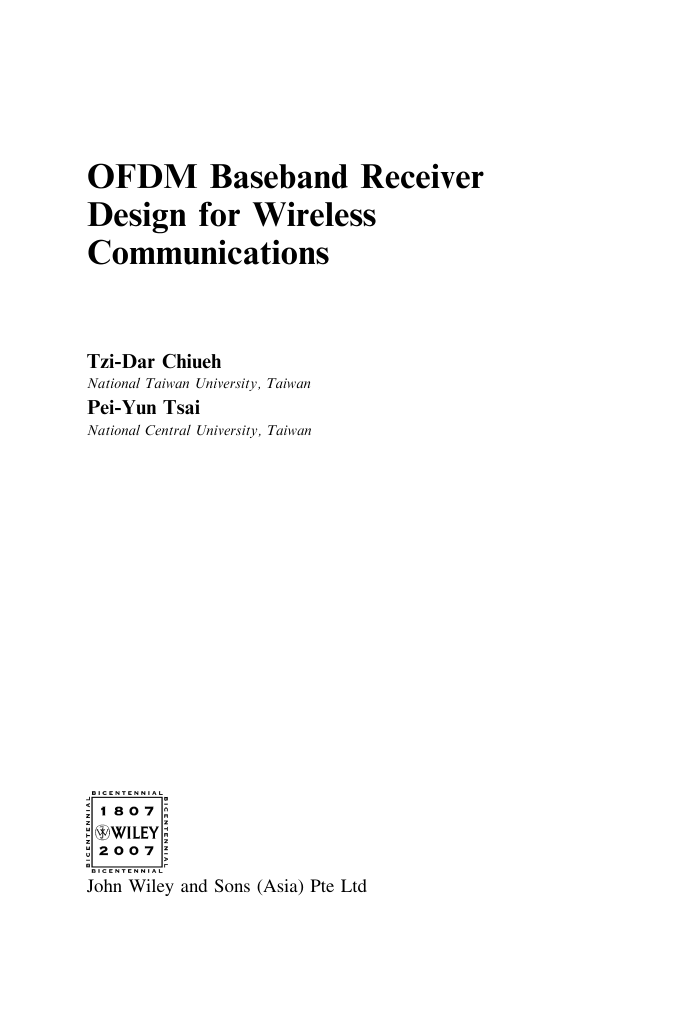


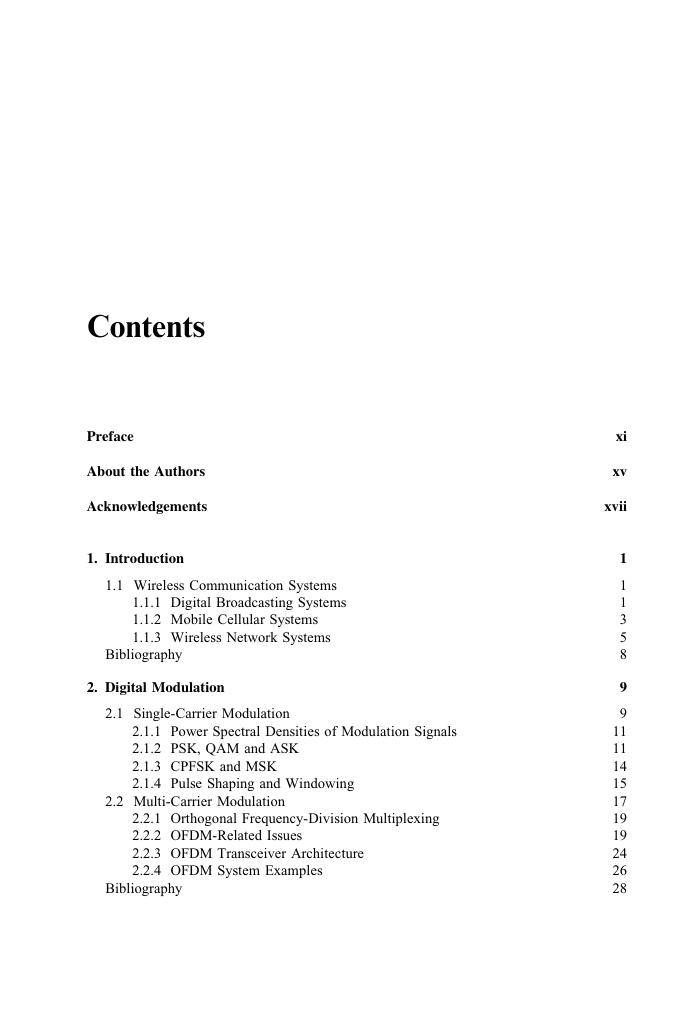
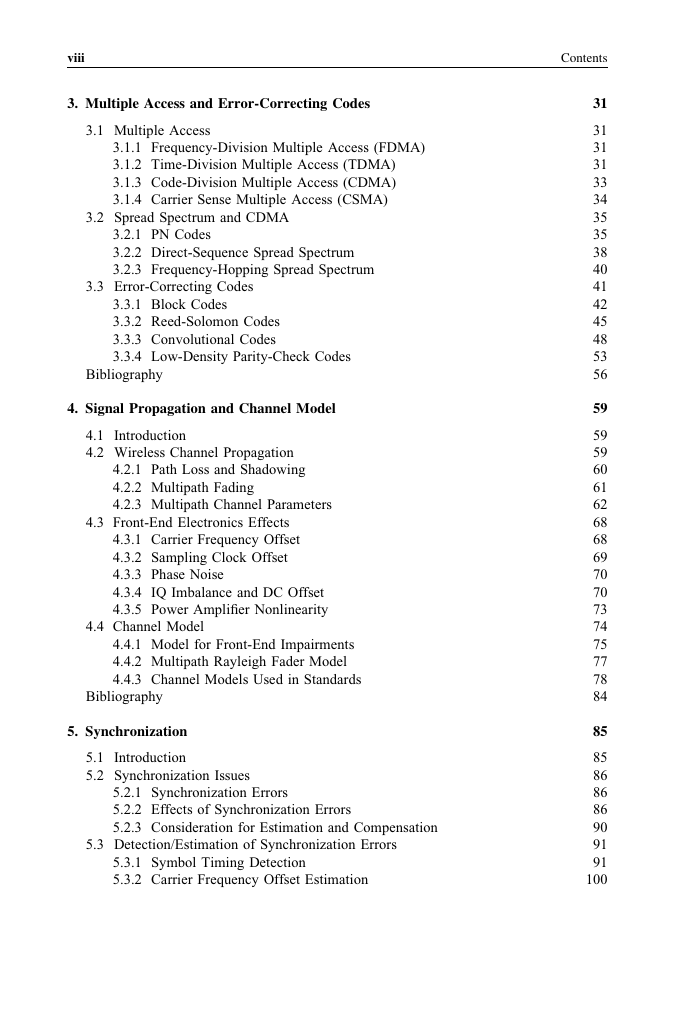

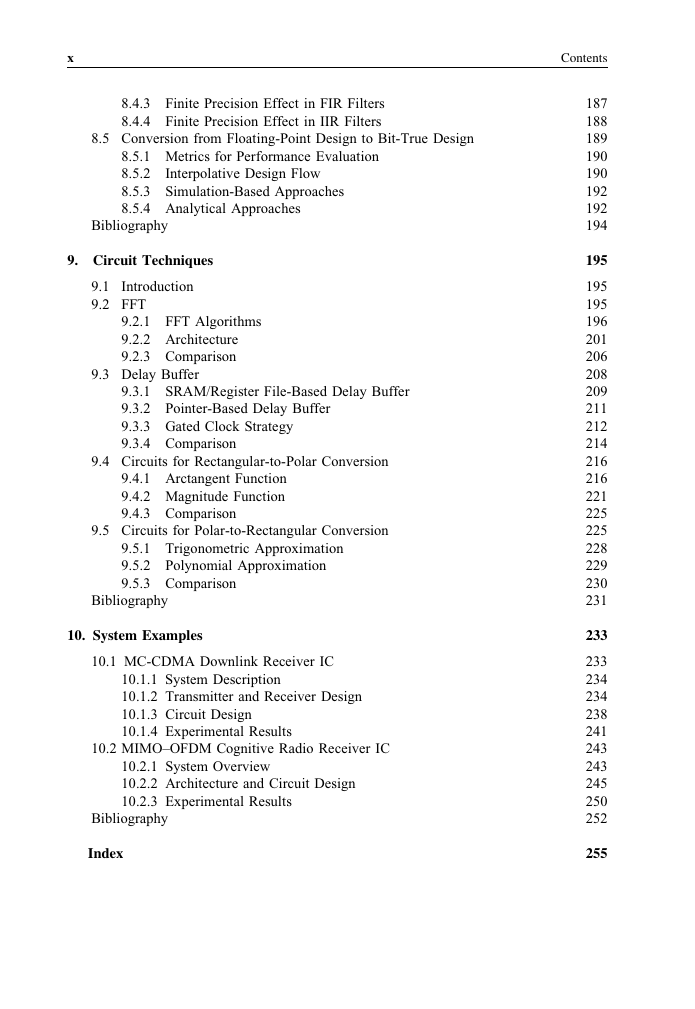








 2023年江西萍乡中考道德与法治真题及答案.doc
2023年江西萍乡中考道德与法治真题及答案.doc 2012年重庆南川中考生物真题及答案.doc
2012年重庆南川中考生物真题及答案.doc 2013年江西师范大学地理学综合及文艺理论基础考研真题.doc
2013年江西师范大学地理学综合及文艺理论基础考研真题.doc 2020年四川甘孜小升初语文真题及答案I卷.doc
2020年四川甘孜小升初语文真题及答案I卷.doc 2020年注册岩土工程师专业基础考试真题及答案.doc
2020年注册岩土工程师专业基础考试真题及答案.doc 2023-2024学年福建省厦门市九年级上学期数学月考试题及答案.doc
2023-2024学年福建省厦门市九年级上学期数学月考试题及答案.doc 2021-2022学年辽宁省沈阳市大东区九年级上学期语文期末试题及答案.doc
2021-2022学年辽宁省沈阳市大东区九年级上学期语文期末试题及答案.doc 2022-2023学年北京东城区初三第一学期物理期末试卷及答案.doc
2022-2023学年北京东城区初三第一学期物理期末试卷及答案.doc 2018上半年江西教师资格初中地理学科知识与教学能力真题及答案.doc
2018上半年江西教师资格初中地理学科知识与教学能力真题及答案.doc 2012年河北国家公务员申论考试真题及答案-省级.doc
2012年河北国家公务员申论考试真题及答案-省级.doc 2020-2021学年江苏省扬州市江都区邵樊片九年级上学期数学第一次质量检测试题及答案.doc
2020-2021学年江苏省扬州市江都区邵樊片九年级上学期数学第一次质量检测试题及答案.doc 2022下半年黑龙江教师资格证中学综合素质真题及答案.doc
2022下半年黑龙江教师资格证中学综合素质真题及答案.doc